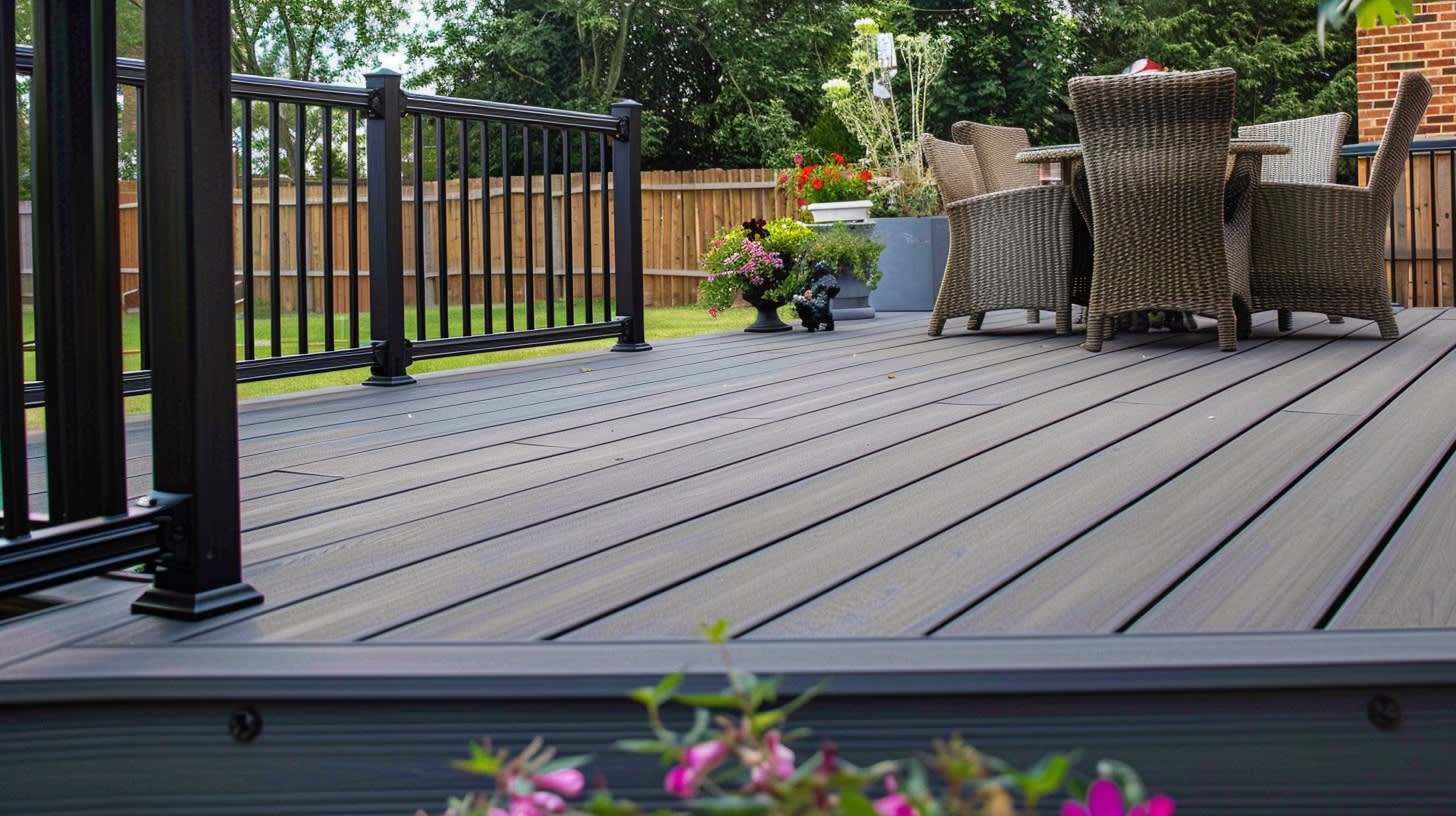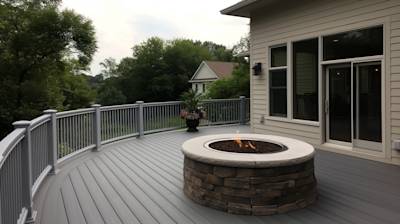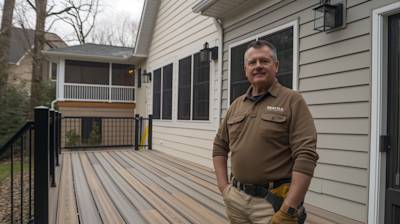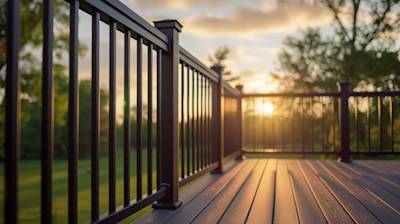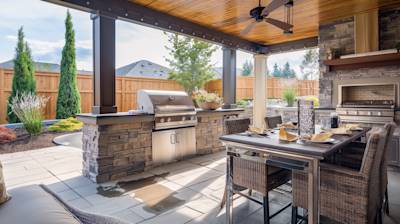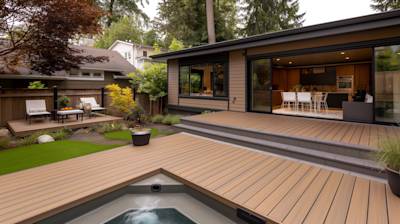Over the past few years, composite decking has risen in popularity among homeowners and builders alike. Thanks to its myriad of benefits, such as longevity and low maintenance, more and more people are considering composite decking as their go-to option for decking. The following article gives an in-depth look into what composite decking is, the materials used, its cost and installation, and maintenance practices.
Understanding Composite Decking
Composite decking is a modern, durable solution for homeowners who want a long-lasting and low-maintenance decking option. Comprising a mix of wood fibers and recycled plastic, composite deck boards are designed to mimic the look and feel of natural wood without the need for regular sealing or staining. This combination of materials gives composite decks improved resistance to weathering, tarnishing, insects, and fading.
Materials and Construction
Composite decking materials are typically a mix of recycled plastic, such as shopping bags and milk jugs, and wood scraps like sawdust, wood chips, and wood fiber pieces. Given that the materials are recycled, composite decking is an eco-friendly option.
The combination of these materials is then heated and compressed into board-shaped lengths and cooled. The end product is a deck board that looks very similar to wood but has the durability and easy maintenance of plastic.
Composite Decking Cost
When it comes to the cost of composite decking, there's no straightforward answer as several factors come into play. These factors include the quality of the composite deck board, the complexity of the deck design, labor costs, and additional features like railings and stairs. On average, however, homeowners can expect to pay more for a composite deck than a traditional wooden deck. But considering the long-term benefits, many homeowners find the investment worthy.
Installation Process for Composite Decking
Prepare Your Sub-Framework
The first step to installing your composite deck is to prepare your deck's sub-framework. Ensure that your deck's joists are installed at the recommended distances for the composite decking you've chosen. This will provide the best support for your deck boards.
Lay Your Composite Deck Boards
Next, start laying your composite deck boards. Align the boards to your desired pattern and ensure they're parallel to each other and your house. Once you're happy with the pattern and alignment, secure the boards to the joists using deck screws or hidden fasteners.
Install Railings, Skirting, and Stairs
After all the deck boards are installed, you can opt to install railings, skirting, and stairs. Although these features are optional, they can enhance your deck's safety and aesthetical appeal. Remember to use composite materials to keep maintenance to a minimum.
Maintenance Practices
Composite decking requires minimal maintenance compared to traditional wood decking. You do not need to sand, seal, or stain the deck. However, to keep the deck in great shape and prolong its lifespan, there are certain practices that you should adhere to:
-
Keeping the deck clean: Regularly sweep or rinse your deck to remove dirt and debris that could scratch or stain the surface.
-
Avoid using harsh chemicals: Use mild soap and water or composite deck cleaners for staining or removal of mold or mildew.
-
Use protective gear: If you're moving heavy furniture around, use a protective mat to avoid scratching your deck.
Composite decking offers an ideal long-lasting, low-maintenance solution for homeowners wanting to improve their outdoor spaces. With its myriad benefits, it is clear why this type of decking continues to gain popularity.
FAQs About Composite Decking
What materials make up composite decking?
Generally, composite decking is made from a mixture of wood fibers and plastic. The exact ratio of wood to plastic varies by brand, but it's usually about 50/50. This mix usually includes recycled materials, making composite decking a more eco-friendly product than pure wood or plastic decks.
How is composite decking different from traditional wood decking?
The key difference between composite and wood decking lies in the materials they're made up of. Wood decking is made entirely of natural wood, while composite decking consists of a blend of wood fibers and plastic materials. Thanks to this composition, composite decking involves less maintenance than wood, is more durable, and often comes with a longer warranty.
How long does composite decking last?
Composite decking is known for its long-lasting durability. On average, a composite deck can last anywhere from 25 to 30 years or even longer with proper care and maintenance. This outlasts most wood decks, which typically need to be replaced after 15 to 20 years.
Is composite decking maintenance-free?
While composite decking is billed as a low-maintenance solution compared to traditional wood decking, it's not completely maintenance-free. It doesn't require painting, staining, or sealing like wood, but it will need an occasional cleaning to prevent mildew and remove dirt. However, its maintenance needs are generally less than that of a wood deck.
Can composite decking be painted or stained?
In general, it's not recommended to paint or stain composite decking. Most composite decks come pre-finished in a range of colors, and their material composition does not hold paint or stain well over time. Additionally, painting or staining can void the manufacturer's warranty.
Can composite decking get moldy?
Although composite decking is designed to resist moisture and reduce the likelihood of mold growth, it is not completely immune. Like any outdoor product, it can still get moldy under the right conditions, especially in shaded areas that stay damp. But cleaning your composite deck regularly can help prevent mold growth.
Is composite decking slippery when wet?
How slippery a composite deck gets when wet depends largely on the product’s texture and the amount of water it is exposed to. Some composite decking options are manufactured with a built-in slip resistance, due to their grain-like patterns. However, any deck can be slippery in wet conditions, so be sure to choose a product with a noticeable texture to provide better traction.
How can I clean my composite decking?
Cleaning composite decking is relatively simple. You can use a soft bristle brush and soapy water to scrub away dirt and debris. For tougher stains and mildew, a composite deck cleaner can be used. High-pressure power washing is not recommended as it might damage the material.
Does composite decking fade over time?
While composite decking is built to be durable and long-lasting, slight fading can happen over time because of constant exposure to sunlight. However, this typically takes many years to occur and the degree of fading depends on the quality of the composite decking you choose.
Pros of Composite Decking
1. Durability
Composite decking is notably durable, making it an alluring alternative to standard timber decking. Key points about its durability include:
- Composite decking is resistant to warping, splitting, and cracking, ensuring a longer lifespan than traditional wood decking.
- The material is practically impervious to most weather conditions, such as rain, sleet, sunshine, and snow.
- The decking is resistant to insects, fungus, and rot, making it an ideal choice for locations with substantial insect or fungal populations.
2. Low Maintenance
Composite decks require significantly less maintenance, which is a major benefit for homeowners. Here are some highlights:
- No need to stain or paint the deck routinely as its unique finish retains its colour for a prolonged period.
- Equipped with a simple clean-up process entailing sweeping and occasional washing.
- There's no need to worry about splinters as they don't occur with composite materials.
3. Environmental Sustainability
Composite decks are made from recycled materials, which adds to their appeal for eco-conscious consumers. This sustainability manifests as follows:
- Manufacturers typically use recycled plastic and repurposed wood scraps, reducing waste.
- Composite decking manufacturing process uses less water and energy compared to traditional wood decking production.
Cons of Composite Decking
1. High Initial Cost
The upfront cost of composite decking can discourage some homeowners. Below are some considerations:
- The initial cost of composite decking is significantly higher than that of wood decking, which can make it unaffordable for some budgets.
- Specific high-end composite decking options can be costlier than premium hardwood decking materials.
2. Aesthetics
While offering diversification in choices, composite decking may not live up to the aesthetics of natural wood. This limitation presents itself in:
- Even with advanced manufacturing techniques, composite decking possesses a look that isn't as natural or traditional as true wood.
- Some homeowners criticize the uniformity of composite decking patterns and colours as they can lack the authentic uniqueness of wood grain.
3. Heat Retention
Composite decks absorb and retain heat more than natural wood, which may be an issue in hot climates. Here's how:
- In direct sunlight, composite decks can become uncomfortably hot, affecting enjoyment in warm weather or potentially causing minor burns.
- Darker colours tend to retain more heat than lighter ones, limiting the colour options if heat retention is a concern.
4. Structural Limitations
Composite decking presents certain limitations in terms of structural strength and usability:
- Composite decks cannot provide a structural framework, and they must be installed on a solid, supportive wooden structure.
- Unlike wood, you cannot sand down or refinish composite decking if it gets damaged or worn. Instead, you may have to replace the entire board.
Summary
There's no denying the allure of composite decking. High on style and low on maintenance, it's the go-to choice for those who want to jazz up their outdoor living space. The variety and versatility of composite decking means you can customize your design to suit your lifestyle and preferences. It's also got you covered with its impressive resistance against weather and wear.
No more worrying about staining, wood rot, or persistent pests with composite decking. Enjoy the natural beauty and comfort of wood without the hassle of constant upkeep. Durable and robust, composite decking is designed to withstand years of memorable barbecues, playtimes, and relaxing afternoons outdoors.
Comparatively, composite decking offers an economic and environmentally friendly choice. Made from a blend of recycled materials, this decking option aligns with the growing trend of sustainable living. Investing in composite decking not only adds value to your property but also to the environment. It’s time to upgrade your outdoor experience with composite decking.
About Seattle Renovation Group
Welcome to Seattle Renovation Group, your top-notch solution for all of your renovation needs in Seattle, WA. Our team of highly skilled professionals are passionate about transforming your living or working spaces into genuinely impressive and functional environments. We pride ourselves in maintaining a commitment to quality, integrity and service, delivering great customer satisfaction, and exceeding the dreams of our clients. Trust us to brighten your world with top-quality renovation services that are simply unparalleled.
Tags: Decking Materials, Outdoor Living, Home Renovation,


